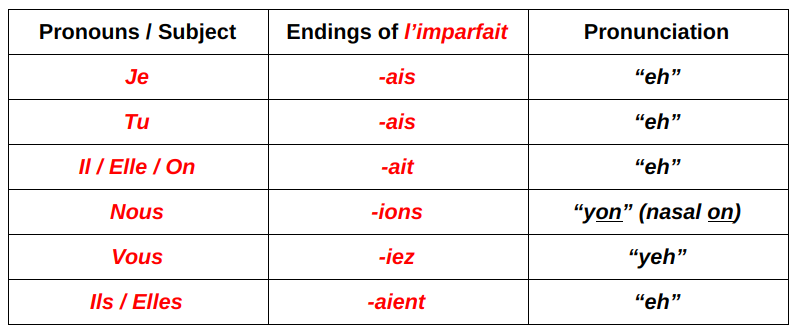


If a certain action covers a significant period of time, we’ll use the imparfait because it’s a continuous action. There are four main situations in which we’ll use the imparfait:Īctions taking place over a period of time
#FRENCH IMPARFAIT ENDINGS HOW TO#
So, now we know how to form the imparfait, but how do we know when to use it?
#FRENCH IMPARFAIT ENDINGS FULL#
The full conjugation would look like: J'étais Then, you can use the same endings as above. To conjugate the exception verb être (to be), instead of modifying the nous form ( sommes), we modify the stem ét. You may need to think about it at first, but as you practice, it’ll become more natural. Now you’re well on your way to smoothly forming the imparfait. Similarly, the full imparfait conjugation for devenir (to become) is: Je devenais Starting to get the idea? Let’s take a look at what the imparfait for other common verbs would be.įor regarder (to watch), all the forms would be: Je regardais Thus, the verb form we get is jouais and our new sentence is: Since you’re talking about yourself, the subject is je.Removing the -ons ending from that form, we come up with jou.The nous form for the verb jouer is jouons(we play).The verb you need here is jouer (to play), as in, je joue du violin (I play violin). Let’s say you want to describe one of your hobbies from high school-playing violin. Add the ending for the appropriate subject, following the pattern below.Remove the -ons ending from the nous form.You can check out this video to learn how to conjugate -er verbs in French: That means that whether the ending of the verb’s infinitive is -re, -ir or -er, the endings are the same. All verbs follow the same pattern, with the sole exception of être (to be), which we’ll cover separately below. The imparfait isn’t difficult to conjugate. Conjugating (Most) Verbs in the Imparfait The imparfait, or imperfect past, is used to describe conditions and continual/repeated actions, which we’ll explain in greater depth later on.įirst, let’s look at how to form the imparfait. (Download) How to Form and Use the Imparfait
#FRENCH IMPARFAIT ENDINGS PDF#
This blog post is available as a convenient and portable PDF that youĬlick here to get a copy. Where to Practice the Imparfait and Passé Composé.How to Use the Imparfait and Passé Composé Together.Conjugating (Most) Verbs in the Passé Composé.Actions taking place over a period of time.Conjugating (Most) Verbs in the Imparfait.You’ll see how to form them and when to use them with examples. In this post, we’ll show you what you need to know about French’s two main past tenses: the imparfait (imperfect tense) and passé composé (perfect tense). The past tense in French will come up often and what can be difficult for French learners is that there are different tenses to talk about the past and each tense describes a certain kind of action that happened. If you pay attention, you’ll find yourself using the past tense several times throughout your day.


 0 kommentar(er)
0 kommentar(er)
